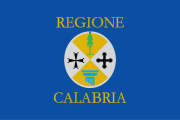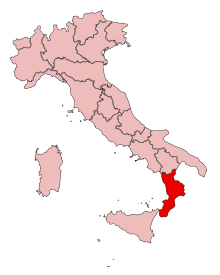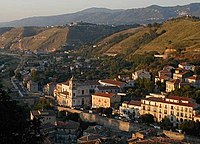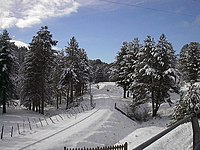Calabria
From Wikipedia, the free encyclopedia
| Calabria | |
 |
|
 |
|
| Geography | |
| Status | Region |
|---|---|
| Capital | Catanzaro |
| President | Agazio Loiero (PDM-Union) |
| Provinces | Catanzaro Cosenza Crotone Reggio Calabria Vibo Valentia |
| Area | 15,081 km² |
| - Ranked | 10th (5.0 %) |
| Population (2006 est.) | |
| - Total | 2,004,415 |
| - Ranked | 10th (3.4 %) |
| - Density | 133/km² |




Calabria (Latin: Brutium), is a region in southern Italy, south of Naples, located at the "toe" of the Italian peninsula. It is bounded to the north by the region of Basilicata, to the south-west by the region of Sicily, to the west by the Tyrrhenian Sea, and to the east by the Ionian Sea. The region covers 15,080 km² and has a population of 2 million. The regional capital is the city of Catanzaro. The other main metropolitan areas are those of Reggio Calabria and Cosenza. The demonym of Calabria is Calabrian (Italian: calabrese).
Contents |
[edit] Geography
Calabria is a narrow peninsula extending into the heart of the Mediterranean for three hundred kilometres. It is located at the tip of the "boot" between the Tyrrhenian Sea to the west and the Ionian Sea and Gulf of Taranto to the east. It is separated from Sicily by the Strait of Messina, where the narrowest point between Capo Peloro in Sicily and Punta Pezzo in Calabria is only 3.2 km. Although the sea seems ever present in Calabria, it is mainly a mountainous region. Three mountain ranges are present: Pollino, the Sila, and Aspromonte. All three mountain ranges are unique with their own flora and fauna.
The Pollino Mountains in the north of the region are rugged and form a natural barrier separating Calabria from the rest of Italy. Parts of the area are heavily wooded, while others are vast, wind-swept plateaus with little vegetation. These mountains are home to a rare Bosnian Pine variety, and are included in the Pollino National Park.
La Sila is a vast mountainous plateau, about 1,200 metres above sea level, which stretches for nearly 2,000 square kilometres along the central part of Calabria. The highest point is Botte Donato, which reaches 1,928 metres. The area boasts numerous lakes and dense coniferous forests.
The peninsula narrows at the Savuto river valley, which starts in the Sila and extends to the Gulf of Sant'Eufemia.
The Aspromonte massif forms the southernmost tip of the Italian peninsula bordered by the sea on three sides. This unique mountainous structure reaches its highest point at Montalto Uffugo, at 1,995 metres, and is full of wide, man-made terraces that slope down towards the sea.
In general, most of the lower terrain in Calabria has been agricultural for centuries, and exhibits indigenous scrubland as well as introduced plants such as the prickly pear cactus (it: Fico d'India). The lowest slopes are rich in vineyards and citrus fruit orchards. Moving upwards, olives and chestnut trees appear while in the higher regions there are often dense forests of oak, pine, beech and fir trees.
Calabria is a land of contrasts, in many respects, with below zero temperatures in the mountains in winter and temperatures sometimes over 40°C in the summer along low valley areas. The climate is typically Mediterranean (Köppen climate classification CSa), except at the highest elevations (DSa, DSb) and the more arid eastern stretches along the Ionian Sea.
Calabria is divided into five provinces:
[edit] History
Calabria was first settled by Italic Oscan-speaking tribes. Two of these tribes included the Oenotri (roughly translated into the "vine-cultivators") and the Itali. Greek contact with the latter resulted in the entire peninsula (modern Italy) taking the name of the tribe.
Greeks settled heavily along the coast at an early date and several of their settlements, including the first Italian city called Rhegion (Reggio Calabria), and the next ones Sybaris, Kroton (Crotone), and Locri, were numbered among the leading cities of Magna Graecia during the 6th and 5th centuries BC. Conquered by the Romans in the 3rd century BC, the region never regained its former prosperity.
The Greeks were conquered by the 3rd century BC by roving Oscan tribes from the north, including a branch of the Samnites called the Lucanians and an offshoot of the Lucanians called the Bruttii. The Bruttii established the main cities of Calabria, including the modern capital, Cosenza (then called Consentia).
After the fall of the Roman Empire the inhabitants were in large part driven inland by the spread of malaria and, from the early Middle Ages until the XVII century, by pirate raids. Calabria was devastated during the Gothic War before it came under the rule of a local dux for the Byzantine Empire. In the 9th and 10th centuries, Calabria, which had been the rich breadbasket of Rome before Egypt was conquered, was the borderland between Byzantine rule and the Arab emirs in Sicily, subject to raids and skirmishes, depopulated and demoralized, with vibrant Greek monasteries providing fortresses of culture. In the 1060s, Normans under the leadership of Robert Guiscard's brother Roger established a presence in this borderland, and organized a government along Byzantine lines that was run by the local Greek magnates of Calabria. In 1098, Pope Urban II named Roger the equivalence of an apostolic legate. The Hauteville clan later formed the precursors of the Kingdom of Naples, which ruled Calabria until the unification of Italy. This kingdom itself came under many rulers: the Habsburg dynasties of both Spain and Austria; the Franco-Spanish Bourbon dynasty, Napoleon's brother Joseph Bonaparte, and then French Marshal Joachim Murat, who was executed in the small town of Pizzo.
Calabria experienced a series of peasant revolts as part of the European Revolutions of 1848. This set the stage for the eventual unification with the rest of Italy in 1861, when the Kingdom of Naples was brought into the union by Giuseppe Garibaldi. The Aspromonte was the scene of a famous battle of the unification of Italy, in which Garibaldi was wounded.
The 'Ndrangheta organized crime families of Calabria began to appear in 1860; they now rival in power the better known Cosa Nostra of nearby Sicily, though they operate completely independently from the Sicilians and are especially active in the cocaine trade.
Until recently, the Mezzogiorno (southern Italy) was among the poorest regions of Europe and impoverished Calabria was a main source for the Italian diaspora of the early 20th Century. Many Calabrians moved to the industrial centres of northern Italy, the rest of Europe, Australia and the Americas (especially Argentina, Brazil, Canada, and the United States). Today, there is increased affluence and a much improved economy based on modern agriculture, tourism, and a growing commercial base. Even though the per capita income is still well below that of northern Italy and central Italy, it has improved to the point where it is approaching the European Union median.[1]
[edit] Demographics
Towns of Calabria with a population of 50,000 or more:
| City | Population |
|---|---|
| Reggio Calabria | 184,504 |
| Catanzaro | 95,099 |
| Cosenza | 70,680 |
| Lamezia Terme | 70,366 |
| Crotone | 60,517 |
The following table indicates the population by province:
| Province | Population |
|---|---|
| Province of Cosenza | 732,615 |
| Province of Reggio Calabria | 565,866 |
| Province of Catanzaro | 368,923 |
| Province of Crotone | 172,970 |
| Province of Vibo Valentia | 168,894 |
Resident population as of 1 January 2005, source Istat
[edit] Culture



[edit] Main Sights
Tourism in Calabria has increased over the years. The main tourist draws in Calabria are the coastline and the mountains. The coastline alternates between rugged cliffs and sandy beaches, and is sparsely interrupted by development when compared to other European seaside destinations. The sea around Calabria is clear, and there is a good level of tourist accommodation. The poet Gabriele D'Annunzio called the coast facing Sicily near Reggio Calabria "...the most beautiful kilometer in Italy" (il più bel chilometro d'Italia). The primary mountain tourist draws are Aspromonte and La Sila, with its national park and lakes. Some other prominent destinations include:
- Reggio Calabria, on the strait between the mainland and Sicily, the largest and oldest city in Calabria, renowned for its fabulous panoramic seaside with botanical gardens between the art nouveau buildings and the beautiful beaches, and its 3,000 years of history with the old Aragonian Castle and the great National Museum of Magna Grecia where the famous Riace Warriors (Bronzi di Riace) are located. More Info on Tourist Web Official Site of Reggio Calabria...
- Cosenza, seat of the Cosentian Academy, is renowned for its cultural institutions, the old quarter, a Romanesque Cathedral and a Swabian Castle.
- Sybaris, on the Ionian sea, is a village situated near the excavation of ancient Sybaris, a Greek colony of the VII century B.C.
- Scilla, on the Tyrrhenian Sea, "pearl" of the "Violet Coast", has delightful panorama, important religious traditions, and is the site of some of Homer's tales.
- Tropea, on the Tyrrhenian Sea coast, is a beautiful town, with a drammatic seaside beach, and the Santa Maria dell'Isola sanctuary. It is also renowned for its sweet red onions (mainly produced in Ricadi).
- Capo Vaticano on the Tyrrhenian Sea, is a very famous wide bathing place near Tropea.
- Siderno on the Ionian Sea coast.
- Gerace, near Locri, is a beautiful medieval city with a Norman castle and an ancient cathedral.
- Squillace, a seaside resort and important archeological site
- Stilo, the home of Tommaso Campanella, with its Norman castle and beautiful Byzantine church, the Cattolica.
- Pizzo, on the Tyrrhenian Sea coast, known for its ice cream called "Tartufo". Interesting places in Pizzo are Piazza Repubblica and the Aragonian castle where Murat was murdered.
- Soverato on the Ionian Sea, Also known as the "Pearl" of the Ionian Sea. Especially renown for its beaches, boardwalk and nightlife.
- Nicotera on the Tyrrhenian Sea, is a beautiful little medieval Town with an ancient Ruffo's castle.
[edit] Language
Although the official national language of Calabria has been Standard Italian since unification (1861), as a consequence of its deep and colourful history, Calabrian dialects have developed that have been spoken in the region for centuries. The various dialects are divided into two different language groups. In the northern one-third of the region, the Calabrian dialects are considered a dialect of the Neapolitan language called Northern Calabrian. In the southern two-thirds of the region, the Calabrian dialects are considered part of the Sicilian language and are grouped as Southern Calabro.
Other historical languages have left an imprint on the region. In isolated pockets, as well as some quarters of Reggio Calabria (historical stronghold of the Greek language in Italy), a hybrid language that dates back to the 9th century, called Griko, is spoken. A variety of Franco-Provençal can also be found in certain communities and French has had an influence on many Calabrian words and phrases. In several villages, the Arbëresh dialect of the Albanian language has been spoken since a wave of refugees settled there in the 15th century. In addition, since Calabria (as well as other parts of southern Italy and Sicily) were once ruled by the Spanish, some Calabrian dialects clearly exhibit Spanish influences.
It is important to highlight the presence of Calabrians in Humanism and in the Renaissance. Indeed the Hellenistics in this period frequently came from Calabria maybe because of the Greek influence. The rediscovery of Ancient Greek was very difficult because this language had been almost forgotten. In this period the presence of Calabrian humanists or refugees from Constantinople was fundamental. The study of Ancient Greek, in this period, was mainly a work of two monks of the monastery of Seminara: Barlaam, bishop of Gerace, and his disciple, Leonzio Pilato. Leonzio Pilato, in particular, was probably a Greek Calabrian born near Reggio Calabria. He was an important teacher of Ancient Greek and translator, and he helped Giovanni Boccaccio in the translations of Homer's works.
[edit] Cuisine
- See also: Calabrian wine
Essentially a typical southern Italian, Mediterranean cuisine with a balance between meat-based dishes (pork, lamb, goat), vegetables (especially eggplant), and fish. Pasta (like in most parts if Italy) is also very important in Calabria. In contrast to most other Italian regions, Calabrians have traditionally placed an emphasis on the preservation of their food, in part because of the climate and potential crop failures. As a result, there is a tradition of packing vegetables and meats in olive oil, making sausages and cold cuts (Sopressata, 'Nduja), and, along the coast, curing fish- especially swordfish, sardines (sardelle rosamarina) and cod (Baccalà). Local desserts are typically fried, honey-sweetened pastries (Cudduraci, scalille or scalidde) or baked biscotti-type treats (such as 'nzudda).
Some local specialties include Caciocavallo Cheese, Cipolla rossa di Tropea (red onion), Frìttuli or Curcùci (fried pork), Liquorice (liquirizia), Lagane e Cicciari (ceci) (a pasta dish with chickpeas), Pecorino Crotonese (Cheese of Sheep), and Pignolata.
Although Calabrian wines are not well known outside Italy, in ancient times Calabria was referred to as Enotria (land of wine). Some vinyards have origins dating back to the ancient Greek colonists. The best known DOC wines are Cirò (Province of Crotone) and Donnici (Province of Cosenza).
[edit] Noted Calabrians
|
vi siete dimenticati MINO REITANO
[edit] References
[edit] External links
- Official Region homepage
- Official Region tourist information
- Web Portal of Calabria in the World
- KALìt Calabria in testa!
- Travel Itineraries: The territory of the Memory
- The first web portal about Calabria
|
|
|
|---|---|
| Abruzzo · Aosta Valley · Apulia · Basilicata · Calabria · Campania · Emilia-Romagna · Friuli-Venezia Giulia · Lazio · Liguria · Lombardy · Marche · Molise · Piedmont · Sardinia · Sicily · Trentino-Alto Adige/Südtirol · Tuscany · Umbria · Veneto | |





